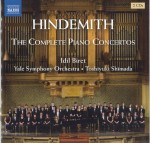 Hindemith – Complete Piano Concertos
Hindemith – Complete Piano Concertos
Idil Biret; Yale Symphony Orchestra; Toshiyuki Shimada
Naxos 8.573201-02
In celebration of the 50th anniversary of the death of Paul Hindemith (1895–1963) Naxos has released a double-disc anthology of his works for piano and orchestra in performances by the Turkish-born pianist and frequent Naxos collaborator Idil Biret and the student ensembles of Yale University under the direction of Professor Toshiyuki Shimada. It is a logical pairing as Hindemith taught from 1940 to 1953 at the prestigious Ivy League school and had previously served in the 1930s as a consultant to the Turkish government, helping to establish the national standards and infrastructure for classical music education.
The earliest work represented here (from 1923), Piano Music with Orchestra (for Piano Left Hand), was commissioned by the affluent Viennese one-armed pianist Paul Wittgenstein. Unfortunately the pianist greatly disliked it and refused to perform it, though by contract he retained the exclusive rights to do so (the same impasse occurred with a work he commissioned from Prokofiev). The score was considered lost until the year 2001, when a copy was discovered in the Wittgenstein family archives. The ever-prolific Hindemith was likely none too concerned, for the lavish $1,000 fee in US dollars he received at the height of the German hyperinflation crisis (equivalent to 30 million marks at the time) enabled him to renovate and move into his dream home, a four-story 14th-century tower in Frankfurt.
The Kammermusik No.2 for piano, string quartet and brass (1924) is a much stronger work, brimming with the saucy inventiveness and powerful brass writing typical of the brilliant Kammermusik series of concertante works for diverse instruments. The same can be said of the innovative instrumentation of the intriguing Concert Music for Piano, Op.49 for two harps and brass (1930). The Yale brass section takes to this music like ducks to water, though all three performances suffer from sloppy co-ordination between the instrumental groups. Whether this is the fault of poor communication between the conductor and pianist or some quirk of the acoustics of the cramped Woolsey Hall stage I cannot say.
The Four Temperaments for piano and strings (1940) began life as a ballet score and is the most often performed of all the works here. Here again an underpowered string orchestra (6.5.4.3.2 in instrumental shorthand, as observed in a YouTube video posted by Ms. Biret) playing in a 3,000 seat convocation hall fails to provide the sonic weight Hindemith routinely demands, though the performers themselves are quite capable. The album closes with the mechanistic Concerto for Piano and Orchestra (1945), the finest moment of which occurs in the surprising final pages with an arrangement of the lively old medieval melody “Tre Fontane.” Perhaps we could consider this retreat into the past as a coded reference to his gothic ivory tower in Frankfurt, now bombed and incinerated.
While the dispirited Bartók and embittered Schoenberg struggled to survive in America, Hindemith’s influence in the United States was profound and his music was widely performed there. By the time of his death however the larger world of composition had turned its back on him. Perhaps it is time to once again grant this grand old lion his due and acknowledge the power, nobility and impeccable craftsmanship of his music; this anthology would be a good place to start.



